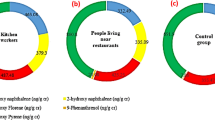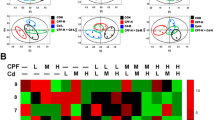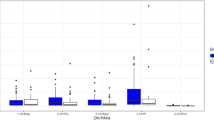Abstract
Di(isononyl)cyclohexane-1,2-dicarboxylate (DINCH) is used as an alternative for some phthalate plasticizers. In rats, DINCH mostly eliminates in feces as cyclohexane-1,2-dicarboxylic acid (CHDA), mono isononyl ester (MINCH) or in urine as CHDA. However, CHDA is not a specific biomarker of DINCH and measuring MINCH in feces is impractical. To identify additional potential biomarkers, we administered DINCH (500 mg/kg body weight) in a single subcutaneous (SC) or oral dose to four adult female Sprague–Dawley rats. We collected 24-h urine samples before dosing (to be used as controls) and 24-h and 48-h after dosing, and serum at necropsy after 48 h. We positively identified and accurately quantified CHDA and cyclohexane-1,4-dicarboxylic acid, mono hydroxyisononyl ester (MHNCH) using authentic standards. Moreover, we tentatively identified MINCH and 12 oxidative metabolites, including 4 cyclohexane ring oxidation products, based on their mass spectrometric-fragmentation patterns. CHDA and MHNCH levels were higher in the urine collected 24 h after oral than SC administration. By contrast, 48-h after dosing, CHDA urinary levels were similar regardless of the exposure route. We detected all but two of the urine metabolites also in serum. Levels of CHDA and MHNCH in serum were lower than in the two post-dose urine collections. Our results suggest that several urinary oxidative metabolites, specifically CHDA, mono oxoisononyl ester and MHNCH may be used as specific biomarkers of DINCH exposure in humans.
This is a preview of subscription content, access via your institution
Access options
Subscribe to this journal
Receive 6 print issues and online access
$259.00 per year
only $43.17 per issue
Buy this article
- Purchase on Springer Link
- Instant access to full article PDF
Prices may be subject to local taxes which are calculated during checkout






Similar content being viewed by others
References
Albro P.W., Thomas R., and Fishbein L. Metabolism of diethylhexyl phthalate by rats. Isolation and characterization of the urinary metabolites. J Chromatogr 1973: 76: 321–330.
Basf A.G. Verfahren zur Hydrierung von Benzolpolycarbonsäuren oder Derivaten davon unter Verwendung eines Makroporen aufweisenden Katalysators. [Patent WO 99/32427], 1999.
Biedermann-Brem S., Biedermann M., Pfenninger S., Bauer M., Altkofer W., Rieger K., Hauri U., Droz C., and Grob K. Plasticizers in PVC toys and childcare products: what succeeds the phthalates? Market survey 2007. Chromatographia 2008: 68: 227–234.
Calafat A.M., Ye X.Y., Silva M.J., Kuklenyik Z., and Needham L.L. Human exposure assessment to environmental chemicals using biomonitoring. Int J Androl 2006: 29: 166–170.
CPSC. Review of Exposure and Toxicity Data for Phthalate Substitutes. (http://www.cpsc.gov/about/cpsia/phthalsub.pdf). 2010, Consumer Product Safety Commission, Washington, DC.
Crespo J.E., Balart R., Sanchez L., and Lopez J. Substitution of di(2-ethylhexyl) phthalate by di(isononyl) cyclohexane-1,2-dicarboxylate as a plasticizer for industrial vinyl plastisol formulations. J Appl Polymer Sci 2007: 104: 1215–1220.
Crespo J.E., Sanchez L., Balart R., and Lopez J. Mechanical properties and fracture surface morphology of DEHP and DINCH based vinyl plastisols. J Elastomers Plastics 2009: 41: 145–161.
Doerge D.R., Twaddle N.C., Vanlandingham M., and Fisher J.W. Pharmacokinetics of bisphenol A in neonatal and adult Sprague-Dawley rats. Toxicol Appl Pharmacol 2010: 247: 158–165.
EFSA. Opinion of the scientific panel on food additives, flavourings, processing aids and materials in contact with foold (AFC) on a request related to a 12th list of substances for foold control materials. EFSA J 2006, 395–401 (http://www.efsa.europa.eu/en/scdocs/doc/395.pdf, accessed 18 November 2011).
Egestad B., Green G., Sjoberg P., KlassonWehler E., and Gustafsson J. Chromatographic fractionation and analysis by mass spectrometry of conjugated metabolites of bis(2-ethylhexyl)phthalate in urine. J Chromatography B 1996: 677: 99–109.
Kato K., Silva M.J., Wolf C., Gray L.E., Needham L.L., and Calafat A.M. Urinary metabolites of diisodecyl phthalate in rats. Toxicology 2007: 236: 114–122.
Koch H.M., and Angerer J. Di-iso-nonylphthalate (DINP) metabolites in human urine after a single oral dose of deuterium-labelled DINP. Int J Hygiene Environm Health 2007: 210: 9–19.
Koch H.M., Muller J., and Angerer J. Determination of secondary, oxidised di-iso-nonylphthalate (DINP) metabolites in human urine representative for the exposure to commercial DINP plasticizers. J Chromatography B-Analytical Technol Biomed Life Sci 2007: 847: 114–125.
McKee R.H., El Hawari M., Stoltz M., Pallas F., and Lington A.W. Absorption, disposition and metabolism of di-isononyl phthalate (DINP) in F-344 rats. J Appl Toxicol 2002: 22: 293–302.
Nativelle C., Picard K., Valentin I., Lhuguenot J.C., and Chagnon M.C. Metabolism of n-butyl benzyl phthalate in the female Wistar rat. Identification of new metabolites. Food Chem Toxicol 1999: 37: 905–917.
Needham L.L., Barr D., Patterson D.G., and Pirkle J.L. Biomonitoring: an integral part of exposure analysis. Neurotoxicology 2004: 25: 666.
Rothenbacher T., and Schwack W. Rapid and nondestructive analysis of phthalic acid esters in toys made of poly(vinyl chloride) by direct analysis in real time single-quadrupole mass spectrometry. Rapid Comm Mass Spectrometry 2009: 23: 2829–2835.
Schmid P., and Schlatter C. Excretion and metabolism of di(2-ethylhexyl)-phthalate in man. Xenobiotica 1985: 15: 251–256.
Sexton K., Needham L.L., and Pirkle J.L. Human biomonitoring of environmental chemicals. Am Scientist 2004: 92: 38–45.
Silva M.J., Furr J., Samandar E., Preau J.L., Gray L.E., Needham L.L., and Calafat A.M. Urinary and serum metabolites of di-n-pentyl phthalate in rats. Chemosphere 2011: 82: 431–436.
Silva M.J., Kato K., Wolf C., Samandar E., Silva S.S., Gray E.L., Needham L.L., and Calafat A.M. Urinary biomarkers of di-isononyl phthalate in rats. Toxicology 2006a: 223: 101–112.
Silva M.J., Reidy J.A., Preau J.L., Needham L.L., and Calafat A.M. Oxidative metabolites of diisononyl phthalate as biomarkers for human exposure assessment. Environm Health Perspectives 2006b: 114: 1158–1161.
Silva M.J., Samandar E., Preau J.L., Reidy J.A., Needham L.L., and Calafat A.M. Quantification of 22 phthalate metabolites in human urine. J Chromatography B-Analytical Technol Biomed Life Sci 2007a: 860: 106–112.
Silva M.J., Samandar E., Reidy J.A., Hauser R., Needham L.L., and Calafat A.M. Metabolite profiles of di-n-butyl phthalate in humans and rats. Environm Sci Technol 2007b: 41: 7576–7580.
Tukova J., Chladek J., Nemcova D., Chladkova J., and Dolezalova P. Methotrexate bioavailability after oral and subcutaneous administration in children with juvenile idiopathic arthritis. Clin Experiment Rheumatol 2009: 27: 1047–1053.
Wadey B.L. An innovative plasticizer for sensitive applications. J Vinyl Additive Technol 2003: 9: 172–176.
Wang R.Y., Wan C.Y., Wang S.F., and Zhang Y. Morphology, mechanical properties, and durability of poly(lactic acid) plasticized with di(isononyl) cyclohexane-1,2-dicarboxylate. Polymer Engineering Sci 2009: 49: 2414–2420.
Acknowledgements
We thank Dr. Raymond David (BASF) for providing DINCH.
Disclaimer
The animal research described in this article has been reviewed by the National Health Environmental Effects Research Laboratory, US Environmental Protection Agency and approved for publication. Approval does not signify that the contents necessarily reflect the views and policies of the Agency nor does mention of trade names or commercial products constitute endorsement or recommendation for use. The findings and conclusions in this report are those of the authors and do not necessarily represent the views of the Centers for Disease Control and Prevention.
Author information
Authors and Affiliations
Corresponding author
Ethics declarations
Competing interests
The authors declare no conflict of interest.
Additional information
Supplementary Information accompanies the paper on the Journal of Exposure Science and Environmental Epidemiology website
Supplementary information
Rights and permissions
About this article
Cite this article
Silva, M., Furr, J., Preau, J. et al. Identification of potential biomarkers of exposure to di(isononyl)cyclohexane-1,2-dicarboxylate (DINCH), an alternative for phthalate plasticizers. J Expo Sci Environ Epidemiol 22, 204–211 (2012). https://doi.org/10.1038/jes.2011.43
Received:
Accepted:
Published:
Issue Date:
DOI: https://doi.org/10.1038/jes.2011.43
Keywords
This article is cited by
-
Urinary metabolites of the UV filter octocrylene in humans as biomarkers of exposure
Archives of Toxicology (2019)
-
Additional oxidized and alkyl chain breakdown metabolites of the plasticizer DINCH in urine after oral dosage to human volunteers
Archives of Toxicology (2017)
-
Quantification of tetrabromo benzoic acid and tetrabromo phthalic acid in rats exposed to the flame retardant Uniplex FPR-45
Archives of Toxicology (2016)
-
Stoffmonographie für 1,2-Cyclohexandicarbonsäure-di-isononylester (Hexamoll® DINCH®) – HBM-Werte für die Summe der Metabolite Cyclohexan-1,2-dicarbonsäure-mono-hydroxyisononylester (OH-MINCH) und Cyclohexan-1,2-dicarbonsäure-mono-carboxyisooctylester (cx-MINCH) im Urin von Erwachsenen und Kindern
Bundesgesundheitsblatt - Gesundheitsforschung - Gesundheitsschutz (2014)
-
Metabolism of the plasticizer and phthalate substitute diisononyl-cyclohexane-1,2-dicarboxylate (DINCH®) in humans after single oral doses
Archives of Toxicology (2013)



